英语教学法翻译,讨论
- 格式:doc
- 大小:30.50 KB
- 文档页数:3
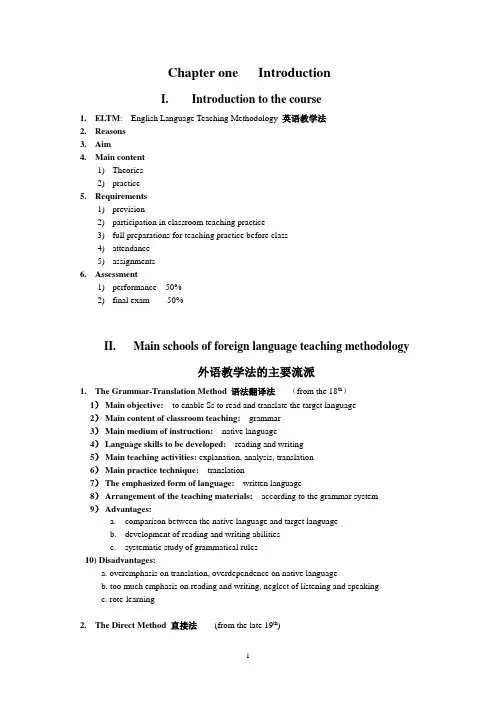
Chapter one IntroductionI. Introduction to the course1.ELTM: English Language Teaching Methodology英语教学法2.Reasons3.Aim4.Main content1)Theories2)practice5.Requirements1)prevision2)participation in classroom teaching practice3)full preparations for teaching practice before class4)attendance5)assignments6.Assessment1)performance 50%2)final exam 50%II. Main schools of foreign language teaching methodology外语教学法的主要流派1.The Grammar-T ranslation Method 语法翻译法(from the 18th)1)Main objective: to enable Ss to read and translate the target language2)Main content of classroom teaching:grammar3)Main medium of instruction:native language4)Language skills to be developed:reading and writing5)Main teaching activities: explanation, analysis, translation6)Main practice technique:translation7)The emphasized form of language:written language8)Arrangement of the teaching materials:according to the grammar system9)Advantages:parison between the native language and target languageb.development of reading and writing abilitiesc.systematic study of grammatical rules10)Disadvantages:a. overemphasis on translation, overdependence on native languageb. too much emphasis on reading and writing, neglect of listening and speakingc. rote-learning2.The Direct Method 直接法(from the late 19th)1)Main objective:to enable the Ss to communicate in the target language2)T eaching language:target language3)The emphasized language form:spoken language (correct pronunciation)4)Language skills :listening, speaking, reading and writing with emphasis onlistening and speaking5)Main teaching technique: direct association of the target language with the physicalworld6) Way of developing the ability to communicate: providing practice in listening andspeaking through imitation and repetition7) Attitude towards the Ss’ errors: intolerant8)Advantages:e of the target languageb.emphasis on language practicec.favorable atmosphere of learning9)Disadvantages:a. overemphasis on the similarities between first language acquisition and secondlanguage learningb. lack of the knowledge of the target language grammarc. very demanding for non-native teachers3.The Audio-lingual Method 听说法(from 1950s)1)Main objective:to enable the Ss to use the target language communicatively2)Language skills: listening, speaking, reading and writing; listening and speakingcome before reading and writing3)Way of presenting the language: using dialogues4)Main practice form: dialogue and pattern drills5)T eaching aids: tapes, language labs, visual aids6)Language used in classroom teaching: target language7) Practice techniques:mimicry, memorization, pattern drills8)Attitude towards the Ss’ errors:intolerant9) Advantages:a.emphasis on the importance of practice in language learningb.development of the separation of the language skillse of the lab10) Disadvantages:a. boredom caused by endless pattern drillsb. teacher’s domination of the class4.The Cognitive Approach 认知法(from 1960s)1)Main objective:to develop the Ss language abilities possessed by native speakers2)Language skills: four skills are equally important3)Main form of language learning:language practice4)Mode of classroom teaching: learner-centered5)Way of teaching : conscious teaching of grammar and language rules6)Attitude towards the Ss’ mistakes:tolerant7)T eaching aims: to teach the Ss language knowledge, language skills and the ability tolearn by themselves8)The focus of classroom teaching :a.rule learningb.meaningful practicec.creativity9)Advantages:a.enjoyable and meaningful learningb.emphasis on the four language skills10)Disadvantages:a.overdependence on analysis and understandingb.not well-researched and developed5.The Communicative Approach 交际法(from 1970s)1)Main objective:to develop the Ss’ communicative competence in the target language2)T eaching mode:learner-centered, task-based3)Language skills: four skills4)Main activities:communicative activities5)Way of learning:by communicating6)Attitude towards the Ss’ errors:tolerant7)Role of the teacher:facilitator, manager, advisor, co-communicator8)Role of the student:communicator, independent learner9)Advantages:a. a very effective approachb.realistic and motivating language practice6.The Audio-visual Method 视听法7.The Oral Approach 口语法8.The Natural Approach 自然法9.T otal Physical Response 全身反应法10.The Silent Way 沉默法munity Language Learning 集体学习法12.Suggestopaedia 暗示法III. Introduction to teaching skills教学技能介绍1.Leading in 导入1) interest2) naturalness3) close connection with new material4) purposefulness5) moderate amount of time2.Asking questions 提问1) proper order2) suitability3) clearness4) time for thinkinging the teaching language语言1) accurateness2) fluentness3) specialization4) understandability5) emotionality6) humorousness4.Presenting and explaining讲解1) emphasis on key and difficult points2) combination with other skills ------ blackboard writing, asking questions, varying3) good organization4) illustration with examples5) proper speed5.varying变化1) voice ( intonation, volume, speed)2) facial expression3) pause and silence4) eye contact with students5) gesture6) position7) teaching method8) interaction pattern9) classroom activity (individual work, group work, games, etc.)6.demonstrating演示1) object2) picture3) card4) slides5) multi-media6) action7.Writing on the blackboard板书1) important points2) standard writing3) good arrangement4) various forms8.Intensifying 强化1)by language2)by body language3)by signs4)by silenceanising 组织1)classroom discipline2)classroom teaching3)interaction between teacher and students4)active involvement of all students in the teaching10.Ending结束1) summarization2) comparison or contrast3) consolidation4) conciseness5) homeworkChapter two English Language teaching in middle schoolsI. Other methods of English teaching in middle schools1. Five – step method 五步法1)revision 复习2) presentation 呈现3) drill 训练4) practice 练习5) consolidation 巩固2. T ask – based approach 任务法A. stages1) pre-task: introduction to the topic and task2) task cycle:a. performing tasksb. planning to report the outcome to the classc. reporting to the class3) post-task: language focusB. types of tasks1) listing2) ordering , sorting, classifying3) comparing4) problem-solving5) sharing personal experienceC. principles of task-designing1) interest2) purpose3) application4) realness5) encouragement6) varietyD. characteristics of task-based language teaching1) purpose2) communication3) cooperationE. Way of learning1) perceiving2) experiencing3) practicing4) communicating5) cooperatingF. Types of activities1) individual work2) pair work3) group work4) full-class workG. Forms of tasks1) oral form2) written formII. Reforms of EL T in middle schools1.New conceptions of ELT in middle schoolsOld New1)T eaching way:explanation; elicitation;impartation discovery2)T eaching mode:teacher-centered; student-centered;text-based activity-based,task-based3)Interaction pattern:T → ST; T →← ST;T →Ss T →←Ss;ST →←ST;ST→←Ss;Ss →←Ss;4)Student’s role:passive listener; active participant;5) Way of learning:rote learning independent learningcooperative learning;inquiring learning 6) T eacher’s role:imparter organizer;participant;guide;facilitator; promoter;7) T eaching method: presentation task-based teaching2. N e w objectives of curriculum in middle school English teaching1) language knowledge2)language skills3) affective; affect4)cultural awareness5)learning strategyIII. Classroom teaching techniques1. Methods of leading in 导入的方法1)by using the illustrations in the book 插图导入法2)by using objects, pictures, slides, videos 直观导入法3)by reviewing what was learned last time if the new material is connected with it复习导入法4)by talking about the background knowledge 背景知识导入法5)by enjoying music 音乐欣赏导入法6)by building a suspense 设置悬念导入法7)by telling a story 故事导入法8)by discussing the topic 讨论导入法9)by asking questions concerning the new topic 提问导入法10)by guessing a riddle 猜谜导入法2. T echniques of asking questions 提问的技巧1) purposes of asking questionsa. focusing learners’ attentionb. arousing learners’ interestc. making learners thinkd. getting feedbacke. developing learners’ oral ability2) types of questionsa. memory questionsb. comprehension questionsc. inference questionsd. extension questions3) characteristics of good questionsa. specificb. worth thinkingc. enlightening4) arts of asking questionsa. being friendlyb. asking from easy questions to difficult questionsc. giving more learners chancesd. commenting promptly and positively5)leading strategies in asking questionsa. giving hintsb. rewordingc. adding more information to the questiond. encouraging learners to guessChapter three Lesson planningI. Lesson preparation1. Aspects of preparation1) aims2) materials: key points; difficult points3) methods4) stages5) teaching aids6) tasks7) types of activities8) blackboard writing design2. How to talk about your teaching 怎样说课1) T alk about your teaching materials 说教材a. status, content and importanceb. teaching focusc. teaching difficultiesd. teaching aids2) T alk about your teaching objectives 说目标a. knowledge 知识b. ability 能力c. culture 文化d. affect 情感e. strategy 策略3) T alk about your teaching methods说教法4) T alk about your learners’ studying ways 说学法5) T alk about your teaching procedure 说教学过程6) T alk about the design of your blackboard writing说板书设计7)T alk about your reflection on the teaching 说教学反思3.How to write a teaching period plan1) T eaching materials:2) T eaching aims:a. knowledge aimb. ability aimc. affect aim3) T eaching focus:4) T eaching difficulties5) T eaching aids:6) T eaching duration: 40 minutes.7) T eaching procedure:Step 1.Step 2.Step 3.Step 4.Step 5.…8) Layout of the blackboard writingII. Basic requirements for classroom teaching1. Basic teaching manners 基本教态1) clear voice2) proper speaking speed3)natural facial expressions4)frequent eye contact with all students5)good posture2. Requirements for teaching1) good teaching manners2) standard teaching language3) clear and correct presentations and explanations4) active involvement of learners5) proper teaching methods3. Classroom teaching practice1) full preparations2) standard teaching plan3) complete teaching procedure4) JEFC teaching materials5) ten minutes’ teachingIII. Lesson variation1. Ways of varying a lesson1) tempo2) organization3) mode and skill4) difficulty5) topic6) mood7) stir-settle8) active-passive2. Criteria for lesson effectiveness1)The class seemed to be learning the material well.2)The learners were engaging with the foreign language throughout.3)The learners were active, attentive, enjoying themselves all the time.4)The lesson went according to plan.5)The language was used communicatively.IV. Classroom interaction1. Most common type of classroom interaction: IRF (Initiation - Response - Feedback)2. Patterns of classroom interaction1) T----S2) T----Ss3) S----S4) S----Ss5) Ss---Ss3. Questioning1) types of questionsa. closed-ended questionb. open-ended question2) criteria for effective questioninga. clarityb.learning valuec. interestd.availabilitye. extensionf. teacher reaction4. Group work1) importance2) organizationa. presentationb. processc. endingd. feedbackChapter four Classroom ManagementI . Classroom discipline1. DefinitionClassroom discipline is a state in which both teacher and learners accept and consistently observe a set of rules about behavour in classroom whose function is to facilitate smooth and efficient teaching and learning in a lesson.2. T eachers’ factors contributing to classroom discipline1) classroom management2) methodology3) interpersonal relationships4) lesson planning5) student motivation3. How to deal with discipline problems1) Before the problem arisesa. careful planningb. clear instructionsc. keep in touch2) When the problem is beginningII. Giving feedback1. Definition of feedbackFeedback is information that is given to the learner about his or her performance of a learning task, usually with the objective of improving this performance.2. Components of feedback1) assessment2) correction3. Forms of feedback4. T echniques of correctionChapter five T eaching pronunciationI. Components of language1. the phonology→pronunciation2. the lexis →vocabulary3. the structure→grammarII. Aspects of pronunciation1. soundsvowels: front vowels, central vowels, back vowels, diphthongseg: 1) he sea; big city; bed beg ; bad bag;2)love does; sir fur; about arrive;3)full could; do who; jaw tore; off top; car jar4)say day; eye why; boy toy; go toe; bow now; here near;hair where; pure sureconsonants: friction consonants, stop consonants, affricate consonants, (voicelessconsonants, voiced consonants,) nasal consonants, lateral consonant, glides(semi-vowels)eg: 1) feel fan; veal van; thieves thanks; these than; sink said; zink,zed;precious vacation; treature, occasion; hat head; rat red2) pear park; bear, bark; tear bet; dear, bed; card cave; guard gave;3) chin cheer; gin jeer; beats carts; beads cards; try trim; dry dream4) me moon; neck not; sing hang5) leave let6) yet yard; we when2. stress: the amount of force with which a sound or syllable is utteredword stress: The stressed syllable in a word is given more force than other syllables when it is utteredsentence stress: Some words are stressed in a sentence. As a rule, the important words in a sentence such as the nouns, adjectives, numerals, demonstrative andinterrogative pronouns, verbs and adverbs are usually given more stressand energy. They are generally stressed more than the other words in asentence. Other grammatical words, e.g. auxiliary verbs, personalpronouns, conjunctions, articles, prepositions, are generally unstressed. 3. rhythm: Each language has its own rhythm of speech. English is read not in single wordswith spaces between them, but in groups of words, several words followingsmoothly one after the other. The intervals between stressed syllables are more orless the same no matter how many unstressed syllables there are in each interval.Thus the stressed syllables occur at fairly regular intervals in English speech. Thisregular reoccurrence of stressed syllables is rhythm.4. intonationIII. Steps of improving learners’ pronunciation1. learners’ perception2. teacher’s description and demonstration3. learners’ practiceIV. T echniques of teaching pronunciation1. demonstrating2. contrasting3. gesturing4. distinguishing5. imitating6. recordingChapter six T eaching grammarI. Content of grammar1. morphology 词法2. syntax句法II. Parts of speech 词类1. noun1)proper noun2) common nouna. individual noun →countable noun →singular formb. collective noun plural formc. material noun →uncountable nound. abstract noun2. verbA. types1) transitive verb2) intransitive verb3) link verb4) auxiliary verb5) modal verbB. forms1) finite forms限定形式a. tenseb. voicei. active voiceii. passive voicec. moodi. indicative moodii. imperative moodiii. subjunctive mood2) non-finite forms 非限定形式a. gerundb. participlec. infinitive3. adjective1) positive degree2) comparative degree3) superlative degree4. adverb5. pronoun1) personal pronoun2) possessive pronoun3) self pronoun4) reciprocal pronoun5) demonstrative pronoun6) interrogative pronoun7) relative pronoun8) conjunctive pronoun9) indefinite pronoun6. article1) indefinite article2) definite article7. conjunction1) coordinating conjunction2) subordinating conjunction8. exclamation: interjection9. numeral1) cardinal numeral2) ordinal numeral3) fractional numeral10. prepositionIII.Types of sentences1. according to the purpose of use1) declarative sentence2) interrogative sentence3) imperative sentence4) exclamatory sentence2. according to the structure1) simple sentence2) compound sentence3) complex sentence4) compound-complex sentenceIV. Parts of sentence 句子成分1. subject2. predicate3. object4. predictive5. adverbial6. attributive1) restrictive attributive clause2) non-restrictive attributive clause7. appositionV. Grammar presentation1. forms2. language3. methods1) the deductive method 演绎法2) the inductive method 归纳法3) the guided discovery method 引导发现法VI. Grammar practice1. mechanical practice1) substitution drills2) transformation drills2. meaningful practiceChapter seven T eaching vocabularyI. Aspects of vocabulary teaching1. form2grammar3collocation4meaning1)denotation2)connotation3)synonym4)antonym5)hyponym6)superordinate7)co-hyponym5word formation1) conversion 转化2) derivation 派生3) compounding 合成II. Ways of vocabulary teaching1. incidental vocabulary teaching 附带性的词汇教学方式1) clues of the contexts 文章上下文线索2) guessing ability 猜词能力3) reading tasks 阅读任务2. explicit vocabulary teaching明确性的词汇教学方式3. connectionist vocabulary teaching连通主义的词汇教学方式III. vocabulary presentation1.concise definition1) Paralympics2) crimson2.detailed description1) bathtub2) mascot3.examples (hyponyms)1) furniture2) beverage4.illustration (picture, object)1) sill2) mouse5.demonstration (acting, mime)1) yawn2) doze6.context (story or sentence in which the item occurs)1) stress2) insomnia7.synonyms1) tube2) culmination8.antonym1) coma2) amiable9.translation1)dimple2) jasmine10.associated ideas, collocations1)sneer2)heaveIV. Strategies of English vocabulary learning1) metacognitive strategy 元认知策略:measures to facilitate learning by actively involvingthe learner in conscious efforts to remember newwordsa. pre-planningb. self-supervisingc. self-evaluating2) cognitive strategy 认知策略: concrete measures to learn vocabularya. consulting dictionaryb. repeatingc. practicingd. reading articlese. sortingf. guessingg. associatingh. translating3) social / emotional strategy 社会/情感策略: measures to learn from each other and toencourage oneselfV. V ocabulary memorizationPrinciple of ACTION1. A=Association 联想2. C=Contrast 对比3. T=Text surroundings 语境4. I=Induction 归纳5. O=Observation 观察N=Note-taking 笔记Chapter eight T eaching listeningI.The two criteria for one’s language proficiency1. accuracy1) pronunciation2) vocabulary3) grammar2. fluency1) listening2) speaking3) reading4) writingII. Classroom listening teaching1. objective2. principles3. materials4. tasks5. stages6. f actors affecting learners’ listeningIII. Major listening strategies1. listening for gist2. listening for specific information3. listening for detailed information4. predicting5. guessing6. inferring7. note-takingChapter nine T eaching speakingI. Basic functions of language1. phatic2. directive3. informative4. interrogative5. expressive6. evocative7. performativeII. Principles of teacher’s oral language1. accuracy2. fluency3. appropriateness4. orderliness5. vividness6. elicitation7. artistry8. interest9. popularization10. educationIII. Factors affecting learners’ speakingIV. Solutions to learners’ speaking problemsV. Speaking strategies1. lowering anxiety2. visualizing3. using non-verbal cues4. paraphrasing1) lexical substitution2) circumlocution5. choosing logical patterns of organization6. analyzing interests of the audienceVI. Speaking activities1. oral fluency activities1) topic-based activity2) task-based activity2. types of oral activities3. characteristics of a successful speaking activityChapter ten T eaching readingI. Types of reading activities1. text+comprehension question activitieseg. Answering comprehension questions (1)READ THE TEXT AND ANSWER THE FOLLOWING QUESTIONS.Y esterday I saw the palgish flester gollining begrunt the bruck. He seemed very chanderbil, so I did not jorter him, just deapled to him quistly. Perhaps later he will besand cander, and I will be able to rangel to him.1) What was the flester doing, and where?2) What sort of a flester was he?3) Why did the writer decide not to jorter him?4) How did she deaple?5) What did she hope would happen later?Answering comprehension questions (2)READ THE TEXT AND ANSWER THE FOLLOWING QUESTIONS.Y esterday I saw the new patient hurrying along the corridor. He seemed very upset. So I did not follow him, just called to him gently. Perhaps later he will feel better, and I will be able to talk to him.1)What is the problem described here?2)Is this event taking place indoors or outside?3)Did the writer try to get near the patient?4)What do you think she said when she called to him?5)What might the job of the writer be?6)Why do you think she wants to talk to the patient?Answering comprehension questions (3)READ THE QUESTIONS AND GUESS WHA T THE ANSWERS ARE GOING TO BE. LA TER, YOU WILL READ THE TEXT AND BE ABLE TO CHECK HOW MANY YOU GOT RIGHT.1)Where was Jane walking?2)What did she hear behind her?3)What was her necklace made of?4)What did the thief steal ?5)What did he do next?As Jane was walking down the street, she heard someone walking quietly behind her.She began to feel afraid. Suddenly a large hand touched her neck: her gold necklace broke and disappeared. In another moment, her bag too was gone, and the thief was running away.2. Reading tasks other than questions1) listing2) ordering , sorting, classifying3) comparing4) problem-solving5) sharing personal experienceII.Factors affecting learners’ reading1. reading habits2. attention3. strategy4. linguistic, cultural and background knowledge5. reading purposeIII. Solutions to learners’ problemsIV. Major reading strategies1. skimming2. scanning3. skipping4. predicting5. guessing6. inferringV.Models of teaching reading1) bottom-up model 自下而上模式2) top-down model自上而下模式3)interactive model 交互作用模式VI. Stages of teaching reading1. pre-reading stage2. while-reading stage3. post-reading stageChapter eleven T eaching writingI. Differences between spoken and written discourse1. permanence2. explicitness3. density4. detachment5. organization6. slowness of production, speed of reception7. standard language8. sheer amount and importanceII. Objectives of writing1. as a means2. as an end3. as both means and endIII. Basic requirements for writing1. content: valuable, interesting ideas2. organization: clear organization, unity, coherence, good use of transitional words3. language: standard language, correct and proper choice of words and phrases, richvocabularyIV.Types of outlines1. topic outline2. sentence outlineV. Writing practice1. sentence2. paragraph1) time2) process3) space4) example5) comparison and contrast6) cause and effect7) classification8) definition3. whole composition1) description2) narration3) exposition4) argumentation4. summary5. book report6. practical writing1) notice2) note3) letter4) resumeVI. Feedback on writing1. focus2. principle of correcting mistakes3. necessity of rewriting4. occasional peer correctionVII. Some common writing errors1. the comma splice 逗号拼接eg. We couldn’t decide upon a new car, there were many attractive models.2. the sentence fragment不完全句eg. They guided us to the edge of the village. Leaving us to find our way home alone.3. the run-on sentence 连续接排句eg. We shopped all day we were very tired by evening.4. dangling element 垂悬成分eg. Looking up at the sky, the sun went under a cloud.To finish the work this morning, time is not enough.While climbing the hill, the rain began to fall.5. misplaced modifier 修饰语错置eg. I listened when he talked attentively.The car is in that garage which was damaged.6. grammar mistake 语法错误7. Chinese English汉语式英语8. meaning unclear意思表达不清9. spelling mistake拼写错误10. logic mistake逻辑错误Chapter twelve Language learning and teachingI. Ultimate goal of learning a languageII. Objectives of teaching a language1. language2. ability1) skillsa. receptive skillsb. productive skills2) integration of four skillsa. simple integrationb. complex integration3. culture4. affect5. strategyIII. Assessment in language teaching1. summative assessment2. formative assessmentChapter thirteen Learner differencesI. Factors affecting language learning1. Intelligence factors1) observation2) attentiveness3) imitation4) memorization5) analysis6) comprehension7) generalization8) creativity9) expression2. Non-intelligence factors1) motivation2) confidence3) will4) teacher-student relationships5) habit6) method7) personalityII. Multiple intelligencesIII. Learner motivation1. integrative motivation and instrumental motivation2. intrinsic motivation and extrinsic motivation3. global motivation, situational motivation and task motivation。
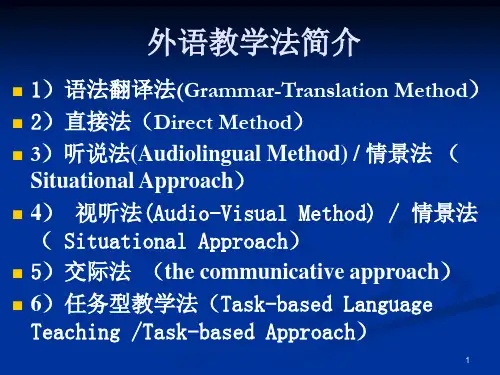
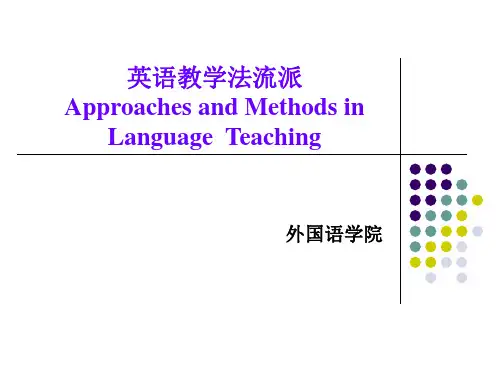
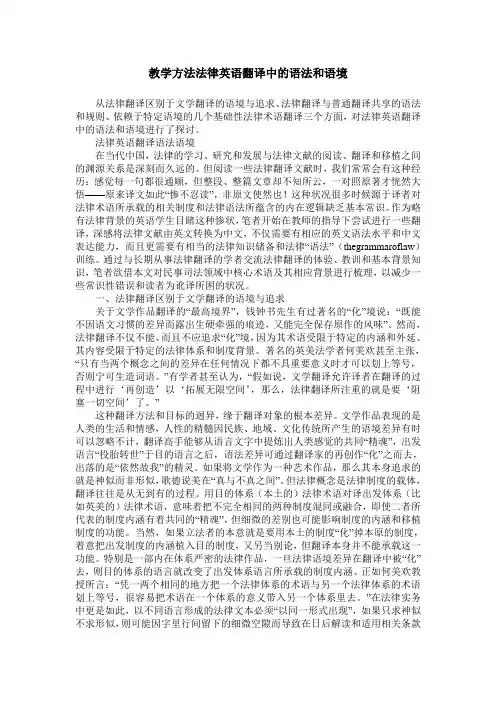
教学方法法律英语翻译中的语法和语境从法律翻译区别于文学翻译的语境与追求、法律翻译与普通翻译共享的语法和规则、依赖于特定语境的几个基础性法律术语翻译三个方面,对法律英语翻译中的语法和语境进行了探讨。
法律英语翻译语法语境在当代中国,法律的学习、研究和发展与法律文献的阅读、翻译和移植之间的渊源关系是深刻而久远的。
但阅读一些法律翻译文献时,我们常常会有这种经历:感觉每一句都很通顺,但整段、整篇文章却不知所云,一对照原著才恍然大悟——原来译文如此“惨不忍读”,非原文使然也!这种状况很多时候源于译者对法律术语所承载的相关制度和法律语法所蕴含的内在逻辑缺乏基本常识。
作为略有法律背景的英语学生目睹这种惨状,笔者开始在教师的指导下尝试进行一些翻译,深感将法律文献由英文转换为中文,不仅需要有相应的英文语法水平和中文表达能力,而且更需要有相当的法律知识储备和法律“语法”(thegrammaroflaw)训练。
通过与长期从事法律翻译的学者交流法律翻译的体验、教训和基本背景知识,笔者欲借本文对民事司法领域中核心术语及其相应背景进行梳理,以减少一些常识性错误和读者为讹译所困的状况。
一、法律翻译区别于文学翻译的语境与追求关于文学作品翻译的“最高境界”,钱钟书先生有过著名的“化”境说:“既能不因语文习惯的差异而露出生硬牵强的痕迹,又能完全保存原作的风味”。
然而,法律翻译不仅不能、而且不应追求“化”境,因为其术语受限于特定的内涵和外延、其内容受限于特定的法律体系和制度背景。
著名的英美法学者何美欢甚至主张,“只有当两个概念之间的差异在任何情况下都不具重要意义时才可以划上等号,否则宁可生造词语。
”有学者甚至认为,“假如说,文学翻译允许译者在翻译的过程中进行‘再创造’以‘拓展无限空间’,那么,法律翻译所注重的就是要‘阻塞一切空间’了。
”这种翻译方法和目标的迥异,缘于翻译对象的根本差异。
文学作品表现的是人类的生活和情感,人性的精髓因民族、地域、文化传统所产生的语境差异有时可以忽略不计,翻译高手能够从语言文字中提炼出人类感觉的共同“精魂”,出发语言“投胎转世”于目的语言之后,语法差异可通过翻译家的再创作“化”之而去,出落的是“依然故我”的精灵。
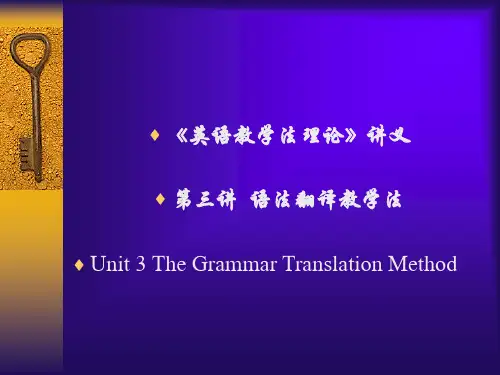

初中英语教学论文浅析英汉翻译与技巧人教版篇一:英语教学论文题目参考英语教学论文题目参考在教学中充分发挥学生的主体作用英语教学中的交际性原则新课程理念下初中英语课堂教学中合作自学的运用高中英语教学中学生主体能动性的发挥初中英语课文写作教学策略深入探讨连动式、兼语式的汉英比较新教材崭新特点引起崭新思索新探索英语非谓语动词的表层结构与深层意义高中英语问题式教学探析三段式在中学英语阅读教学中的运用英语教学“课堂引入”的原则和方法参与、合作、探究的英语教学模式浅谈中学英语兴趣教学构建基于信息技术的多维互动的思想品德课教学体系初中英语教学中独立自主与合作自学方式的融合应用领域词汇法教学在英语教学实践中的应用高中学生英语会话能力脆弱的原因及解决办法在外语教学中培养为交际而运用英语的能力英语教学必须彰显人文关怀练习在英语课堂教学中的运用浅谈英语教学中对学生主体意识的挖掘中学初级阶段英语教学浅谈英语探究性课堂教学法例谈论浅谈提高英语听力教学的方法初中英语口试的紧迫性和可行性研究浅谈中小学生英语学习与心理素质的关系浅谈高中英语如何运用启发式教学唤起学生积极主动思维浅谈如何培养中学生英语的兴趣构筑适宜学生的教学模式发展学生综合运用语言的能力中学生英语听力障碍及克服方法初探英语教学中课堂气氛与教学效果浅谈关于英语后阶段复习冲刺的学习策略与建议英语课堂创设教学活动情境的途径注意英语学习策略培训提高学生自主学习能力如何在英语教学中培育学生较好的语感注重方法培养能力提高质量――谈高中英语的复习试谈思政课中案例与活动教学的有效率资源整合中学英语教学与“学困生”心理素质教育语境设置与中学英语教学外语教学中如何使用语言实验室初中英语的句型教学预制语块与中学英语口语教学多媒体技术在英语情景教学中的应用领域英语课堂教学中的创新教育初中英语课堂教学应当彰显“四化”试析母语在外语教学中的作用崭新课程体系下中学生英语自学能力的培育初中英语新教材的特点及教法初探浅谈初中生自学英语过程中的两极分化开发中学英语校本课程资源的若干原则运用任务型教学展开初中英语文学创作训练谈初中英语课堂教学的心理学策略英语教学中交际能力的培育英语教学中学生记忆能力培养浅谈哲学及其教学与创造性思维培育浅谈随意联想在英语教学中的实施高中英语素质教育与较好自学习惯的培育运用课堂技巧培养学生学习英语的兴趣高中英语教学的负面因素及对策浅谈英语教学中的句型转换问题初中英语开放式课堂教学研究课程改革与英语教学现状――调研报告综述谈论如何转化成高一学生的英语元自学能力外语教学中语用能力的培养深入探讨高职英语听力认知的对策英语课创造思维的培养与探究文化差异和中学英语教学英文中学英语新课程与学生学习方式变革的研究――浅谈学生的自主学习合作学习与探究学习阐释英语评价体系谈谈中考英语书面抒发的阶段训练从初中英语新教材谈英语教育实习交际教学法在中学英语课堂中的应用领域搞好课文阅读活动提高阅读效率和能力―――初三英语unit11lesson42教学案例试论“任务型”教学模式在课文教学中的运用英语教学中应当著重学生创新能力的培育高中英语阅读教学中的创新思维方式也谈论创造性地采用教材优化英语学习环境激活口语课堂从转型期英语教学课堂教学谈论中学英语教学改革的方向当前中小学英语自学心理障碍成因分析浅谈高中英语阅读课文教学新课程实行中英语课堂教学的“设疑”方法初中英语教学中自学创造力的研发在英语教学中实施形成性评价浅谈高中英语写作能力的培育浅谈学生意志品质的培养奠定学生主体地位做好中学英语教学实施过程完整化教学模式提高高中英语教学质量建构主义与英语新课标下的语言学习英语任务型教学的研究与运用加强语言实践活动活跃英语交际气氛通过阅读教学培育学生英语写作能力关于英语教学改革的思路运用现代教育媒体提升英语活动课效果中学生英语学习策略现状调查与评价审美教育英语教学的新天地学生英语听闻能力的培育注重形成性评价培养学生英语自主学习能力浅谈英语课堂教学中学生的主体作用对英语词汇教学的思索谈英语学习者语言能力的培养在英语教学中如何唤起学生自学兴趣略论学生英语交际能力的培养浅谈有关任务型语言教学的重新认识与积极探索高中英语课文整体教学法探略培育和提升学生英语的互动交际能力英汉语词汇文化内涵异同与英语教学英语教学中跨文化自学能力的培育浅谈英语教学中的合作学习提升学生英语听力的教学策略英语口头表达能力训练的四个阶段网络环境下的英语合作自学及活动设计浅析英语课堂教学的互动性新世纪高职英语教学面临的问题和对策初中英语复习教学中实施素质教育的探索改进英语阅读教学切实提高学生素质浅谈虚拟语气现代教育技术在英语新课程改革中的应用领域探究身体语言在英语教学中的辅助促进作用浅谈现代英语课堂教学英语学习策略及在课堂中的训练中专英语听力教学和听力训练尝试方法英语教学如何培育学生创新能力英语听力教学的困难分析与对策高中英语新教材阅读教学原则摭谈论创新思维在高中英语教学中的培养中学英语教学贯彻落实全系列语言教学理念的体会与课堂教学对高中英语教学忽略英语朗诵现象的思索英语教学与学生素质培育之深入探讨谈英语教学中学生学习自主性的培养篇二:初中英语论文初中英语阅读教学的点滴体会全文阅读教学是中学英语教学的重要组成部分,当前很多老师的阅读教学方法陈旧,导致学生阅读兴趣不高,在中考阅读题中失分较多,本文紧扣新课改标准,结合自己的教学实践,从教学引入、教学重点、阅读补充等入手,为做好阅读教学提供了参考。

英汉语言对比与翻译教案一、教学目标1. 让学生了解英语和汉语在语音、语法、词汇、表达习惯等方面的差异。
2. 培养学生运用翻译技巧进行英汉互译的能力。
3. 提高学生对文化差异的敏感性,增强跨文化交际能力。
二、教学内容1. 英汉语言对比:语音、语法、词汇、表达习惯等方面的差异。
2. 翻译技巧:直译、意译、借译、归化等。
3. 文化差异:英汉文化背景、习俗、价值观等方面的差异。
三、教学方法1. 对比分析法:通过对比分析英汉两种语言的差异,让学生深入了解并掌握其特点。
2. 案例教学法:提供典型英汉互译案例,引导学生运用翻译技巧进行实践。
3. 讨论法:组织学生就文化差异展开讨论,提高他们的跨文化交际能力。
四、教学安排1. 英汉语音对比:4课时2. 英汉语法对比:4课时3. 英汉词汇对比:4课时4. 英汉表达习惯对比:4课时5. 翻译技巧讲解与实践:8课时6. 文化差异讨论:4课时五、教学评价1. 课堂参与度:观察学生在课堂上的发言和讨论情况,评估他们的学习积极性。
2. 翻译练习:布置英汉互译练习,评估学生的翻译能力和对翻译技巧的掌握程度。
六、教学活动与实例1. 英汉语音对比:通过播放英汉两种语言的语音样本,让学生识别并对比其差异。
例如,英语中的元音和辅音发音规则与汉语的声调特点对比。
2. 英汉语法对比:分析英汉两种语言的句子结构、时态、语态等方面的差异。
例如,英语的被动语态和汉语的无主句对比。
3. 英汉词汇对比:对比英汉两种语言中词汇的构成、词义差异和词性转换。
例如,英语的派生词和汉语的成语对比。
4. 英汉表达习惯对比:通过对比英汉两种语言在日常交流中的习惯用法,让学生了解并掌握其差异。
例如,英语的直接引语和汉语的间接引语对比。
七、翻译技巧训练1. 直译:在忠实原文的基础上,将英汉两种语言的词汇、语法结构等进行直接对应翻译。
例如,将英语的被动语态直接翻译为汉语的被动语态。
2. 意译:在忠实原文的基础上,根据汉语的表达习惯对英汉两种语言的词汇、语法结构等进行调整。
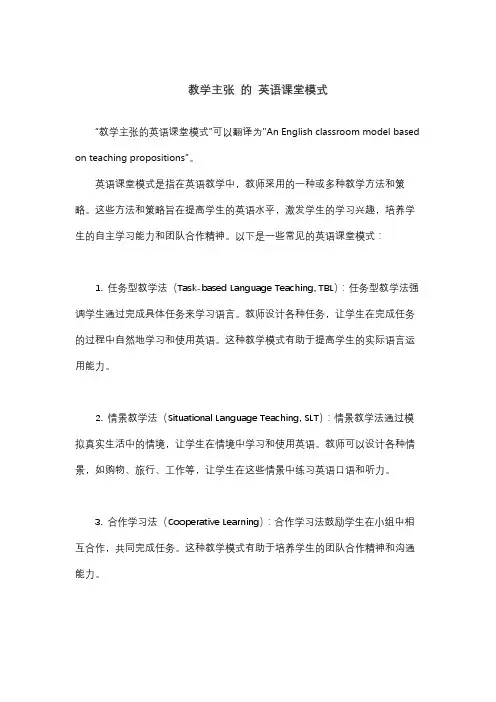
教学主张的英语课堂模式“教学主张的英语课堂模式”可以翻译为"An English classroom model based on teaching propositions"。
英语课堂模式是指在英语教学中,教师采用的一种或多种教学方法和策略。
这些方法和策略旨在提高学生的英语水平,激发学生的学习兴趣,培养学生的自主学习能力和团队合作精神。
以下是一些常见的英语课堂模式:1. 任务型教学法(Task-based Language Teaching, TBL):任务型教学法强调学生通过完成具体任务来学习语言。
教师设计各种任务,让学生在完成任务的过程中自然地学习和使用英语。
这种教学模式有助于提高学生的实际语言运用能力。
2. 情景教学法(Situational Language Teaching, SLT):情景教学法通过模拟真实生活中的情境,让学生在情境中学习和使用英语。
教师可以设计各种情景,如购物、旅行、工作等,让学生在这些情景中练习英语口语和听力。
3. 合作学习法(Cooperative Learning):合作学习法鼓励学生在小组中相互合作,共同完成任务。
这种教学模式有助于培养学生的团队合作精神和沟通能力。
4. 交际法(Communicative Language Teaching, CLT):交际法强调学生通过与他人交流来学习语言。
教师应该关注学生的语言交际能力,而不仅仅是语法和词汇知识。
5. 分层教学法(Differentiated Instruction):分层教学法根据学生的不同水平和需求,提供不同难度的教学活动。
这种教学模式有助于满足每个学生的学习需求,提高教学效果。
6. 翻转课堂(Flipped Classroom):翻转课堂是指学生在课前通过网络学习课程内容,课堂时间主要用于讨论、解决问题和进行实践活动。
这种教学模式有助于提高学生的自主学习能力和课堂参与度。
7. 项目式教学法(Project-based Learning):项目式教学法通过让学生参与实际项目,培养他们的实践能力和创新精神。
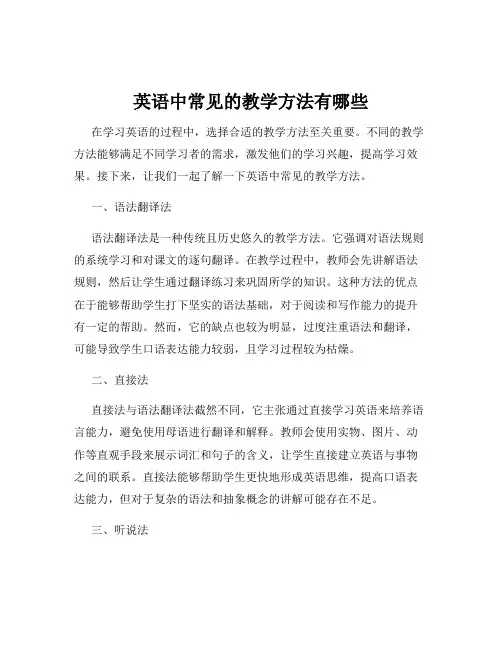
英语中常见的教学方法有哪些在学习英语的过程中,选择合适的教学方法至关重要。
不同的教学方法能够满足不同学习者的需求,激发他们的学习兴趣,提高学习效果。
接下来,让我们一起了解一下英语中常见的教学方法。
一、语法翻译法语法翻译法是一种传统且历史悠久的教学方法。
它强调对语法规则的系统学习和对课文的逐句翻译。
在教学过程中,教师会先讲解语法规则,然后让学生通过翻译练习来巩固所学的知识。
这种方法的优点在于能够帮助学生打下坚实的语法基础,对于阅读和写作能力的提升有一定的帮助。
然而,它的缺点也较为明显,过度注重语法和翻译,可能导致学生口语表达能力较弱,且学习过程较为枯燥。
二、直接法直接法与语法翻译法截然不同,它主张通过直接学习英语来培养语言能力,避免使用母语进行翻译和解释。
教师会使用实物、图片、动作等直观手段来展示词汇和句子的含义,让学生直接建立英语与事物之间的联系。
直接法能够帮助学生更快地形成英语思维,提高口语表达能力,但对于复杂的语法和抽象概念的讲解可能存在不足。
三、听说法听说法强调通过大量的听力和口语练习来掌握语言。
教学中会使用对话、句型操练等方式,让学生反复模仿和记忆。
这种方法注重语言的流利性和准确性,对于培养学生的听说能力非常有效。
但它可能忽视了语言的意义和语境,导致学生在实际运用中缺乏灵活性。
四、情景教学法情景教学法通过创设各种真实或模拟的情景,让学生在具体的情境中学习和运用语言。
教师会设计各种场景,如购物、旅游、聚会等,让学生在这些场景中进行角色扮演和交流。
这样的教学方法能够使学生更好地理解语言的实际用途,增强语言运用的能力,同时也能提高学习的趣味性。
五、交际教学法交际教学法的核心是培养学生的交际能力。
它强调语言的功能和用途,鼓励学生在真实的交际场景中运用所学的语言进行交流。
教师会组织各种小组活动、讨论等,让学生积极参与到语言交流中。
这种方法能够提高学生的语言综合运用能力和跨文化交际能力,但对于语法和词汇的系统学习可能不够重视。
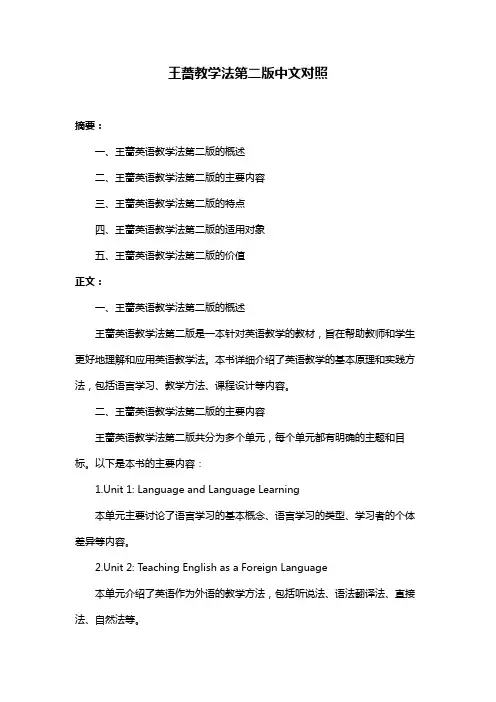
王蔷教学法第二版中文对照摘要:一、王蔷英语教学法第二版的概述二、王蔷英语教学法第二版的主要内容三、王蔷英语教学法第二版的特点四、王蔷英语教学法第二版的适用对象五、王蔷英语教学法第二版的价值正文:一、王蔷英语教学法第二版的概述王蔷英语教学法第二版是一本针对英语教学的教材,旨在帮助教师和学生更好地理解和应用英语教学法。
本书详细介绍了英语教学的基本原理和实践方法,包括语言学习、教学方法、课程设计等内容。
二、王蔷英语教学法第二版的主要内容王蔷英语教学法第二版共分为多个单元,每个单元都有明确的主题和目标。
以下是本书的主要内容:1.Unit 1: Language and Language Learning本单元主要讨论了语言学习的基本概念、语言学习的类型、学习者的个体差异等内容。
2.Unit 2: Teaching English as a Foreign Language本单元介绍了英语作为外语的教学方法,包括听说法、语法翻译法、直接法、自然法等。
3.Unit 3: Curriculum Design本单元讨论了课程设计的原则、方法和步骤,以及课程评价的策略。
4.Unit 4: Teaching Grammar本单元重点介绍了语法教学的基本理论和实践方法,包括语法教学的范围、目标、方法和评估。
5.Unit 5: Teaching Vocabulary本单元讨论了词汇教学的重要性、方法和策略,以及如何提高学生的词汇学习效果。
6.Unit 6: Teaching Listening and Speaking本单元介绍了听力和口语教学的原则、方法和活动设计,以及如何提高学生的听力和口语水平。
7.Unit 7: Teaching Reading and Writing本单元讨论了阅读和写作教学的方法、策略和评估,以及如何提高学生的阅读和写作能力。
8.Unit 8: Teaching Culture本单元重点介绍了文化教学的重要性、方法和策略,以及如何培养学生的跨文化交际能力。
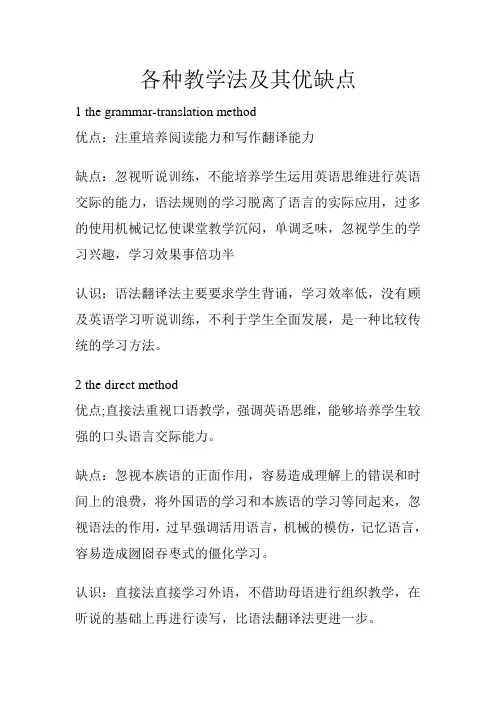
各种教学法及其优缺点1 the grammar-translation method优点:注重培养阅读能力和写作翻译能力缺点:忽视听说训练,不能培养学生运用英语思维进行英语交际的能力,语法规则的学习脱离了语言的实际应用,过多的使用机械记忆使课堂教学沉闷,单调乏味,忽视学生的学习兴趣,学习效果事倍功半认识:语法翻译法主要要求学生背诵,学习效率低,没有顾及英语学习听说训练,不利于学生全面发展,是一种比较传统的学习方法。
2 the direct method优点;直接法重视口语教学,强调英语思维,能够培养学生较强的口头语言交际能力。
缺点:忽视本族语的正面作用,容易造成理解上的错误和时间上的浪费,将外国语的学习和本族语的学习等同起来,忽视语法的作用,过早强调活用语言,机械的模仿,记忆语言,容易造成囫囵吞枣式的僵化学习。
认识:直接法直接学习外语,不借助母语进行组织教学,在听说的基础上再进行读写,比语法翻译法更进一步。
3 audio-lingual method优点:听说法的优势是通过句型操练熟练掌握一定数量的句式,有利于语言表达习惯的养成,在有限范围内,能流利的听说英语,语调比较准确自然。
缺点:听说法的训练过于机械,脱离实际,忽视语言文化和语言情景等交际要素,造成大量无意义的表达。
熟练掌握并流利表达的句式不能在实际生活中有效运用,教学过程中有错必纠的方法使学生失去学习热情,影响他们的学习积极性。
认识:听说法的学习策略是听说领先,读写跟上。
其学习训练方式较多样化,符合学生要求,如果注重句式在生活上的灵活运用会更好。
4 the situational language teaching优点:便于使学生获得感性材料,把理论与实际联系起来。
有利于调动学生的非智力因素,使学生注意力集中,学到的知识易于掌握巩固。
缺点:完全排除母语,不利于对语言材料的彻底理解。
过分强调整体结构的感知,使学生对语言项目缺乏清楚的认识。
认识:情景交际法能让学生更加容易理解所学内容,能够身临其境的学习外语,是一种比较可靠的教学方法,但需要准备的材料多,操作较麻烦。
一、语法翻译法(The Grammar-Translation Method)语法翻译法产生于18世纪末的欧洲。
它是用母语翻译教授外语书面语的一种传统外语教学法,即用语法讲解加翻译练习的方式来教学外语的方法,也叫古典法(Classical Method)、旧式法(Old Method)。
其代表人物是德国的奥朗多佛(H.Ollendorff)。
翻译法的主要特点是:(1)用母语组织教学。
把母语做释义、讲解、练习和检查的重要手段,很少积极使用目的语。
(2)以传统语法作为教授外语的基础。
语法被当作语言的核心,是外语学习的主要内容。
语法讲解采用演绎法,先讲解语法规则,然后在练习中运用,巩固规则。
(3)侧重培养阅读能力。
语法翻译法把口语和书面语分离开来,把阅读能力的培养当作首要的或惟一的目标。
口语教学局限于使学生掌握词汇的发音。
翻译法的主要优点是:(1)创建了在外语教学中利用母语的理论,成为外语教学史上最早的一个教学法体系。
它的出现为建立外语教学作为一门独立的科学体系奠定了基础。
(2)系统讲授语法知识,注意利用学生的理解力,有利于启发思维,训练智慧,有助于提高教学效果。
(3)重视通过大量阅读、背诵原著培养阅读能力。
(4)便利易行。
教师只要掌握了外语基础知识,就可以拿着教科书教学,无需什么教具和设备。
翻译法的主要缺点是:(1)没有抓住语言的本质,只重视书面语,而忽视口语教学,忽视语音和语调教学。
(2)过分强度翻译的作用,使学生容易养成使用外语时依赖翻译的习惯,不利于培养学生外语进行交际的能力。
(3)过于强调语法在教学中的作用。
语法讲解从定义出发,根据定义给例句,脱离学生的实际需要和语言水平。
(4)强调死记硬背,教学方式单调泛味,因而课堂气氛沉闷,难以调动学生学习的积极性二、直接法(The Direct Method)直接法产生于19世纪90年代,是外语教学史上的一次革新,是批评语法翻译法的产物。
它是通过外语本身进行会话、交谈和阅读来教外语,而不用母语,不用翻译和形式语法,也就是直接学习、直接理解、直接应用。
大学英语教学中英语翻译法与交际法的交互运用摘要:有效的课堂教学有助于学习者语言的习得。
本文通过分析广泛应用的语法翻译法和交际法,指出特点,探讨这两种方法在我国大学英语教学中的交互运用,从而指出教学方式的多样化才能满足教学实践的需要。
关键词:英语教学语法翻译法交际法一、引言在大学英语教学实践中,为了适应大学英语教学改革的新要求,采取何种教学模式能够使习得者尽快获得目的语成了一个十分重要的问题。
有效的课堂教学模式有助于加强语言能力,学习者是通过对语言知识的不断输入和积累而最终获得一定的语言技能,所获得的语言技能又促使学习者习得新的语言知识,这就决定了学习者的语言知识具有阶段性的特征。
针对语言的阶段性特征,我们便要根据不同的阶段,采取不同的教学模式。
本文通过分析语法翻译法和交际法,探讨这两种方法在英语教学中的应用。
二、语法翻译法语法翻译法,是在外语教学过程中强调语法的构建作用的一种教学方法。
它的主要实践技巧就是在目的语和母语中进行互译(译自(stern,1983:453))。
语法翻译法最早于18世纪末期,在普鲁士被应用于现代课堂语言教学。
在19世纪,它被认为是研习文学作品,进行思维训练必不可少的环节,它并不注重听说能力的重要性。
语法翻译法的基本步骤包括:列出语法规则;分析句子篇章的语法结构;借助句子对语法规则进行操练。
学习者的母语被当作学习外语的辅助语言。
jack c.richards(2000:3)总结语法翻译法的主要特点如下:其目的为读懂文学作品以通过考试,同时进行思维训练。
(1)读和写是其主要的侧重,听说能力不被重视。
(2)词汇教学借助双语词汇表,词典和死记来展开。
(3)句子是教学的基本单位,侧重将包涵语法规则的句子在新学语言和母语间互译。
(4)准确程度的标准高于流利程度。
(5)语法通过先整体后分析的方式来教学,然后配以相关的练习实践。
(6)母语是教学的媒介。
总之,语法翻译法侧重讲授系统的语法知识和培养读写能力而忽略听说,目的语和母语间的互译是最主要的教学手段,目的语的应用不被重视,它对教师的外语应用能力要求不高。
论翻译教学法对大学英语教学的启发摘要:随着我国经济发展的不断壮大,与国际化接轨的速度越来越快,我国对外语人才的需求量也在与日俱增。
可是当前的大学英语教学中出现了过度重视学生听说能力的培养,而忽视了对学生翻译技能的培养和锻炼,导致了中国人才市场上翻译人才的奇缺状况。
本文首先介绍了当前大学英语教学中翻译教学的现状、分析了翻译教学被忽视的原因,最后重点分析了大学英语教学中翻译教学的方法和技巧,希望通过本文的分析来提高学校以及广大师生对翻译技能的重视和培养。
关键词:翻译教学;大学英语;英语教学;方法技能一、当前大学英语教学中翻译教学的运用现状翻译教学在大学英语教学内容中应该是一项非常重要的内容,也是必不可少的技能训练课程。
在外语学习和培训过程中,听、说、读、写、译是老师要重点培养学生的五个方面的能力。
翻译只是占到了这些能力中的五分之一,再加上上世界七八十年代发生的英语教学纷争,导致了目前高校普遍重视学生听说能力的培养,而忽视了其翻译能力的训练。
这样会导致学生书写翻译能力和口头翻译的下降,而社会上缺少的正是这些高素质的翻译人才。
二、翻译教学在当前大学英语教学中被忽视的原因分析1、学校教学设备以及教学资源不完备。
目前大学英语教材中出现的生词量比较大,学生在大学课堂上通过反复的阅读和记忆来学习这些生单词,由于学校缺乏预言多媒体教学设备,无法使学生在学到这些单词后加以运用和巩固,无法达到学生之间、师生之间运用新学单词组句翻译和对话的实际教学需求。
此外,还有很多高校的教师资源不足,导致英语学习班学生数量较多,规模较大,无法达到师生之间的充分交流,翻译教学法更是难以实施。
2、大学英语教师对翻译教学作用的忽视以及教师专业教学水平有限。
自从上世纪七八十年代英语教学界发生了新旧教学方法纷争后,教师们的教学重点逐渐转移到了对学生听说能力的培养,而对翻译能力则是蜻蜓点水似的点拨。
担心汉语的解说影响学生听说能力的培养,大学英语教师在课堂上甚至很少用汉语,也很少用汉语对整篇文章进行翻译和解说。
浅析语法翻译法、情景法和听说法摘要: 语法翻译法、情景法和听说法是3种非常重要的外语教学方法, 对我国外语教学产生了深远影响。
但每种教学方法都有其不同的理论基础, 都有其各自的优点和缺点。
将从背景、理论与模式等方面对此3 种教学方法进行分析与讨论, 以便能对我国的外语教师有一定的启示作用。
关键词: 语法翻译法; 情景法; 听说法在外语教学理论研究中, 有关教学法的讨论非常多, 关于不同的教学法的优缺点的争论也非常热烈。
众所周知, 教学法会直接影响到我们的教学效果, 两种不同的教学法可能会导致完全不同的教学效果, 所以怎样才能探究到一种合理、有效的外语教学法是所有外语研究者、教师和学习者都非常关注的问题。
外语教学法是一门研究外语教学的学科, 它既要有一定理论基础, 又要密切联系教学实践, 同时更要贯穿于整个教学过程给予一定的规范和指导。
长期以来, 众多的专家、学者和教师一直在不断的进行尝试和探索, 他们依托重要的外语教学理论, 借鉴和吸取国外的有效教学法, 同时又充分结合中国的外语教学现状, 试图找到一种最为行之有效的教学方法。
于是, 有关各种教学法的讨论与比较纷纷呈现。
其中, 语法翻译法、情景法和听说法都对我国的外语教学产生了重要的影响, 本文将从背景、理论与模式等方面对此三种教学法进行阐述。
1 语法翻译法、情景法和听说法1 . 1 产生背景语法翻译法起始于18 世纪晚期的欧洲, 在外语教学史上具有悠久的历史, 同时也是我国外语教学史上使用范围最广, 而又最具有生命力的教学方法之一。
在18 世纪, 教学的主要目的就是学习书面拉丁语, 阅读文学作品, 而这正是语法翻译法的特点之一。
语法翻译法最早是由德国学者麦丁格( J o h a n n V al e n t i n M e i d i n g er ) 和费克( J oha nn Ch r i sti a n F i c k )倡导并提出的。
在我国早期的大学英语教学中, 主要也是采用了此种教学法。
英语教学方法有哪几种1. Communicative Language Teaching (交流式教学法): 这种方法侧重于提高学生的语言交流能力,通过实际的交际活动来帮助学生掌握语言技能。
2. Task-Based Language Teaching (任务型教学法): 这种方法将语言教学与实际任务相结合,要求学生通过完成任务来实践语言运用。
3. Content-Based Instruction (以内容为基础的教学法): 这种方法将语言学习与学科知识相结合,以提高学生的学科知识和语言能力。
4. Total Physical Response (全身反应法): 这种方法通过运动、动作和身体反应来帮助学生理解和掌握语言。
5. Cooperative Learning (合作学习法): 这种方法通过学生之间的合作学习来提高语言能力,培养学生的团队合作和沟通能力。
6. Suggestopedia (暗示式教学法): 这种方法通过创造宽松、积极的学习环境,激发学生的学习兴趣和潜能。
7. The Silent Way (沉默法): 这种方法强调学生的主动参与和发现,教师在教学中保持沉默,让学生自己探索和发现语言规律。
8. Community Language Learning (社区语言学习法): 这种方法强调建立积极的、互动的学习社区,通过教师和学生的合作来帮助学生学习语言。
9. Lexical Approach (词汇法): 这种方法强调词汇的教学和运用,认为词汇是语言学习的核心。
10. Grammar-Translation Method (语法-翻译法): 这种方法侧重于教授语法知识和翻译技巧。
Name:刘芳芳 Number:1125010908 Date:2013/10/31 一.Translation 1. Students should have continuous interests and hobbies in English learning. Besides, they should use simple English to greet to others, to exchange personal, family, and friends’ simple information. They also should perform on the dialogue and ballad according to what they have learned. Further more, they should understand, read and state simple stories with the help of pictures and prompts. They are also expected to be willing to participate in, cooperate with others actively, ask for advice initiatively, and know foreign cultures and customs. 2.They should have a specific motivation and active attitude toward English learning. Besides, they should understand the familiar topics that the teacher said and be happy to join in the discussion. They also should learn to exchange information and state their own opinions of various topics in daily life, read simple reading materials, magazines and journals provided for seven to nine grade learners. Further more, they should overcome these new words regarded as obstacles to comprehension, and use appropriate reading strategies according to the reading purposes. In addition, they are asked to draft and revise composition according to tips, to cooperate with others, to solve the problems and present report outcomes, and to complete learning tasks with others. At last, they should learn to make use of all kinds of educational resources and have a further understanding of cultural differences. 3.Students should have a specific and continuous learning motivation and self-learning consciousness. They also should be able to exchange information, ask questions and state their own opinions and suggestions of the familiar topics. They can read English original works and English newspapers provided for senior high school students. Besides, they should have the preliminary writing ability, such as event notification and letter of invitation. Participate in plans, organization actively, and implement language practice. Moreover, they should expand and use learning resources actively, obtain information from multiple channels, and express themselves clearly using what they have obtained. They should have a strong ability of self-evaluate and self-control to form suitable learning strategies. At last, they are asked to understand the cultural differences and form preliminary awareness of intercultural communication. 二.Discussion As far as I am concerned, the descriptions of level standards relate to the overall goals of the curriculum. Such as students’ interests and confidence, learning strategies, basic English language knowledge, skills, students’ various abilities, and their awareness of cultural differences and so on. In level 2, it mentions students’ continuous interests and hobbies in English learning. It also asks for students’ basic knowledge, for example, it advises students to communicate with others using simple English. Besides, it also refers to students’ cooperation with others. At last, it asks students to aware cultural differences. In level 5, it demands a higher standard than level 2. In this part, it mentions students’ learning motivation and attitudes. It also mentions students’ skills, like reading all kinds of reading materials, writing small compositions, listening, speaking and changing ideas with others. Besides, it emphasizes cooperation once again, because it asks students to cooperate with others and finish the tasks together with their classmates. It also mentions students’ abilities to assess their learning activities, to use educational resources from multiple channels. Finally, it asks students to have a further understanding of the cross-culture differences. In level 7, it mentions some elements which have appeared before. Students’ initiative is emphasized for several times. For example, it asks students to join in the plans, organizations and do the implement of language practice initiatively, and students also should expand educational resources initiatively. Furthermore, it also mentions students’ skills, such as skills of writing, communicating and reading original English works and magazines. Besides, it mentions learning strategies. And finally, it emphasizes the awareness of cross-cultural differences.